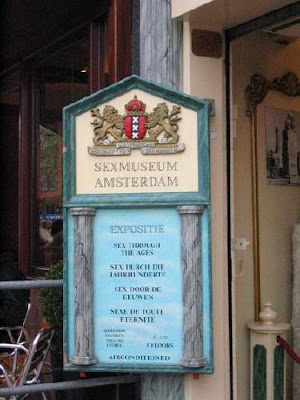Amsterdam has 160 canals with a combined length of 76km (47 miles) and spanned by 1,281 bridges. The first thing to do is take a canal ride on one of 70 tour boats. From the water level, one can appreciate the beauty and uniqueness of those gabled canal houses and picturesque bridges. Most of Amsterdam's buildings have gables, and are tall and narrow due to hefty property taxes and expensive canal front land. The hijsbalk, the hook on the many gables, are used with rope and pulley for hauling large, heavy items in and out of homes that have steep, narrow staircases. From the bridge over Reguliersgracht at Keizersgracht, one gets a view of seven parallel bridges.
 Canal cruise. Photo at bottom left is the view of the seven parallel bridges
Canal cruise. Photo at bottom left is the view of the seven parallel bridges
Sint-Nicolaaskerk (St. Nicholas's Church), a short walk away from the Centraal Station, was opened in 1887. Restored in 2000, it is the city's main Catholic church. The neo-Baroque church has twin towers and a high domed cupola. At the heart of what was once the old harbor, it started out as a place of worship for seafarers (of whom St. Nicholas is the patron).
The city's first great Gothic church, the Oude Kerk, is Amsterdam's oldest monument, dating back to 1250. Of particular interest are the organ, the stained glass windows, the tomb of naval heroes and a floor paved with tombstones beneath which are 2,500 graves, including that of famous Dutch artist Rembrandt's wife, Saskia. Nowadays, the pretty gabled almshouses around the Oude Kerk feature red-fringed windows through which can be seen the scantily clad ladies of the Red Light District, a sex-for-sale zone which occupies a beautiful area of 16th-century canals and gabled houses.
 The Oude Kerk
The Oude Kerk
 Red Light District
Red Light District
For more than two centuries after Amsterdam's 1578 Protestant Alteratie (Changeover), other Christian denominations were forbidden to worship openly. Clandestine places of worship sprang up around the city. The best known of these was the Catholic Our Lord in the Attic, now the Museum Amstelkring. The Catholic Church, also in the middle of the Red Light District, is in the attic of one of the oldest canal houses transformed in 1661-63 by wealthy Catholic merchant Jan Hartman to house a church. Worshipers entered by a door on a side street and climbed a narrow flight of stairs to the hidden third-floor church. After navigating the steep stairways into the attic, one is greeted by a large baroque altar, religious statuary, pews to seat 150, an 18th-century organ, and an upper gallery beautifully furnished with heavy oak furniture, Delft tiles, and period paintings.
 Museum Amstelkring
Museum Amstelkring
 RAI Congress Centre - the venue of the congress I attended
RAI Congress Centre - the venue of the congress I attended
(to be continued…)







2 comments:
amsterdam is really a nice place...hope can go there 1 day
Oh.. for business.. that's really nice.. Europe is a far fetch place for us to go.. for business.
Post a Comment